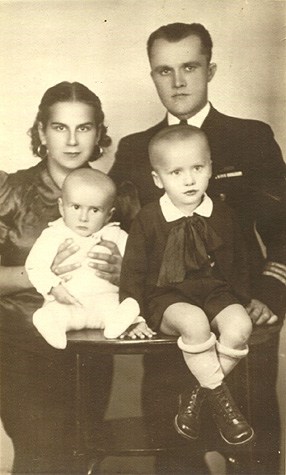

On the departing ships bridge standing next to the commanding officer, Signalist Petty Officer, Polish Naval Reserve Stefan Wesolowski on orders from Captain Wlodzimierz Kodrebski sent this deeply moving signal to Poland on the eve of the start of WWII. Little did we know at that time what horrors awaited us and the Polish people for almost seven years?
The Polish Navy at that moment initiated OPERATION PEKIN which directed the Polish naval flotilla to sail in secret to England and become a part of the British Naval force for the duration of the war.
On 1 st of September at 17:35 the small Polish fleet arrived at Liege England to start its operations against Nazi Germany.
Stefan Wesolowski in 1940
The following is a story of one of the 197 crew members of ORP Blyskawica whose experience and destiny ended as a citizen of the United States via battles of the North Atlantic, Narvik, Normandy, Sicily and the Pacific.
HERO OF TWO NATIONS
CAPTAIN STEFAN P. WESOLOWSKI, (1909-1987)
By Prof. Dr. Zdzislaw P. Wesolowski
There are few times in our lives when human beings appear who incorporate all of the flamboyance, courage, and virtue that we all aspire to within ourselves, particularly as during the chaotic and dangerous years of World War II.
The combination of these traits are nonexistent in the development of our modern society today which is based more on cynicism than faith, more on personal gratification than an exaltation of the spirit for the common good; a loss of moral fiber in the face of adversity. Tom Brokaw in his book, THE GREATEST GENERATION eludes to this unselfish love of country and sacrifice. In his second book, THE GREATEST GENERATION SPEAKS he mentions Captain Stefan P. Wesolowski.
It seems today that the magnificent accomplishments and aspirations of the world during the 19th and early 20th centuries have been replaced now by an engulfing sense of self-indulgence and weakening moral responsibility and self-discipline. Yet, we cannot despair for the human race when we are fortunate enough to come across the story of human beings that fulfill all of the loftiest of humanity’s aspirations. We all live by examples, good or bad, of human endeavor. Here is an example of one story that soars to its highest form of human behavior and achievement.

Ian A. Millar, an American Naval Historian noted in an article on Captain Stefan P. Wesolowski, the following; „Heroes sometimes attain this exalted status not as the result of a single act, but rather through a career of outstanding accomplishment that earn them this honor. Heroes may come and go, but very often we read about an individual whose values and fortitude reflect that which we as freedom loving people admire. Such is the story of Captain Stefan P. Wesolowski who fought for freedom from the age of nine. One must admire the convictions of a man like this, and to his heroic service. Beyond this I find great admiration for him and his perseverance in service while his family remained in the German occupied land of his birth, Poland”.
Captain Stefan P. Wesolowski in 1980 in Florida.
SOLDIER OF POLAND AT 9, CORPORAL AT 12

Captain Stefan Ogonczyk Wesolowski was born on January 31, 1909 in Warsaw during the occupation of Poland by Czarist Russia. His family background dates back to old Polish nobility and is one that is steeped in patriotism. The Wesolowski family took an active part in the service of the Polish-Lithuanian Kingdom, at the very height of Polish historical strength in Central Europe.
His father, Lucjan participated in the Revolution of 1905 and his grandfather, Seweryn took part in the January Uprising of 1863 against
Stefan Ogonczyk Wesolowski in 1918.
The great-grandfather, Jozef, participated in the November Uprising of 1830. Since 1792, twenty-two members of the Wesolowski family received Poland’s highest decoration for military valor, the Order of the Virtuti Militari.
Stefan Wesolowski followed in this family tradition of patriotism at the early age of 9 when he ran away from home to join Pilsudski’s Legions. In 1918 at the age when most children are concerned with toys and not national issues, Stefan participated as a soldier in the Polish War of Independence. For his services, primarily as a scout, during this turbulent period of Polish military history, Stefan Wesolowski received Poland’s highest honor for valor and gallantry under fire. He was awarded the Order of Virtuti Militari for the defense of Lwow where he was instrumental in taking and holding a strategic position. He received the second highest decoration, the Cross of Valor for his military contributions during the 3rd Silesian Uprising. There he conducted nightly reconnaissance operations across enemy lines camouflaged as a girl pulling a cow to pasture. No one suspected a little girl of military activity.
In addition to these decorations, Stefan Wesolowski was promoted to the rank of corporal at the tender age of 12, becoming the youngest noncommissioned officer in the history of Polish military services. He was later awarded decorations for Silesia, Wolyn and Lwow as an additional point of recognition for his military service in these campaigns.
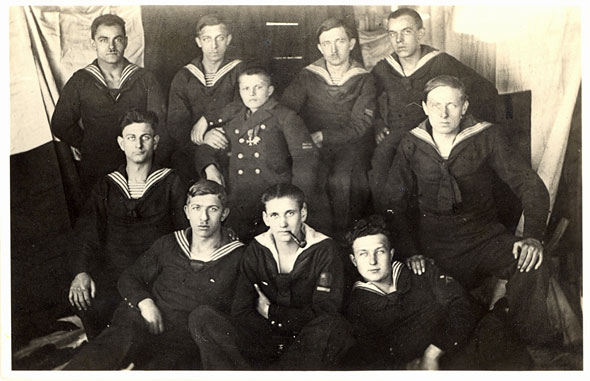
Stefan Ogonczyk Wesolowski ( in the middle) in 1922.
In spite of this valorous service in the land forces of the newly nascent Poland, Stefan Wesolowski’s future became intrinsically involved in his country’s naval forces. Having listened to intriguing stories of the sea, recounted by his comrades in arms, he left the ranks of the army after the Silesian campaign. Young Wesolowski traveled directly to Wejherowo where he joined the crew of the „Abdank”, He later served on the „Gazolina” the first ship of the fledgling Polish Merchant Marine. He was the only Pole on the crew. The Captain asked Stefan to sew a Polish flag and in a short flag raising ceremony, Stefan raised the Polish flag on the first Polish Merchant Marine ship in over 350 years. In the spring of 1922 at the age of 13, Wesolowski decided to join the Polish Navy and was inducted with the rank of Petty Officer.
His first assignment was as a commander of a ten-man observation and communication post between Gdynia and Oksywie. By sheer weight of personality and experience he was able to overcome his age barrier with his men and they readily accepted his leadership. After a period of shore duty he served on various Polish naval ships as well as naval vessels of the French Navy. He served aboard „the Bourrasque”, „Fortune” and „Condercet” of the French Navy This provided him with specialist training in range finding and communication in naval operations.
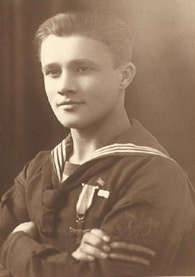
After eight years of active duty with the Polish Navy, Wesolowski transferred to the naval reserve and returned to Merchant Marine duty. In 1930 upon receiving his captain’s diploma, Wesolowski became the skipper of the seagoing tug „Pollox” and became intimately involved in the construction of the Polish port of Gdynia, assisting in the enormous dredging operations that involved the waterways in the port city of Wladyslawowo. In 1933 he joined the Gdynia Port Authority and served as a pilot at that facility.
In 1934 he married Antonina and two sons, Zdzislaw and Jeremii resulted from this happy union.
Stefan Ogonczyk Wesolowski in 1927.
By 1936, Captain Wesolowski had become established in his naval career and life seemed to have taken a serene pattern of hard, but interesting work and the additional personal satisfaction of a happy married life.
Wedding of Stefan and Antonina in 1934.
In 1938 Stefan and Antonina were looking for a retirement home having by then completed 20 years of government service. Little did they know that in Germany, a dictator had different plans for them and Poland.
THE SECOND WORLD WAR
Suddenly with the consolidation of power in Germany in the hands of Adolph Hitler, and the weakening response of the Western powers to his territorial demands, Poland found herself in a state of complete mobilization on August 24, 1939.
The independence and tranquillity of his country, that he had fought so valiantly for in the 1918-1921 period, was now, only 21 years later, to be challenged once again by her ancient enemy, Germany.
Stefan, Antonina Wesolowski and two sons, Zdzislaw and Jeremii.
Mobilized with the rest of the Polish forces, Captain Wesolowski received his assignment on board the Polish submarine ORP Orzel. However, neither this assignment nor the subsequent one on the destroyer ORP Wicher were successful since during the early, confusing aspects of the general mobilization both craft were by then fully crewed before his arrival. Interestingly and ironically, both of these vessels were sunk during the war. Finally, after the initial confusion of mobilization, Captain Wesolowski was assigned to the destroyer ORP Blyskawica as a signalist.
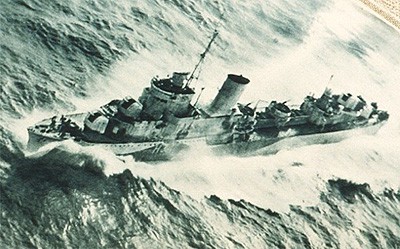
Realizing the enormous odds against survival of the small Polish fleet against the overwhelming naval forces of Nazi Germany, the ORP Blyskawica, ORP Burza and ORP Grom with Wesolowski and others were ordered to leave the port of Oksywie and head on a straight course for England.
On the bridge of the Blyskawica with its captain Wlodzimierz Kodrebski was Petty Officer Stefan Wesolowski. Captain Kodrebski directed Wesolowski to send the following message bidding Poland and their countrymen goodbye at 14:15 on 30 August 1939, „SZCZESC BOZE KU CHWALE OJCZYZNY”.
None realized the agonizing years of separation from family and country that awaited them. For those who survived the agonies and frustrations of the Second World War, it would mean six years of separation from families and their beloved homeland.
BATTLES IN THE ENGLISH CHANNEL AND NARVIK
On September 9th, 1939 the small Polish flotilla of destroyers entered Plymouth harbor after passing through the Baltic Sea, the Swedish Sound and the North Sea – always under pressure as primary targets of the German fleet. Assigned to North Sea patrols, now Petty Officer Stefan Wesolowski, remained with his ship for over a year, The winter of 1939 was particularly terrible and exerted its toll on the health and lives of the men assigned this dangerous duty. On November 7th, 1939 the ORP Blyskawica was attacked by German aircraft, but fortunately survived the torpedo attack. In the spring of 1940 Hitler launched his attack against Norway and the Polish ships and an Army Brigade of Polish Highlanders were dispatched to Narvik to help in the defense of Norway. During the course of this disastrous battle the sister ship to the ORP Blyskawica, the ORP Grom, was bombed and sunk by the German Luftwaffe. However, both ships inflicted heavy damage to the German forces at Narvik by their intense bombarding of the shore. During the furious battle the ships were able to shoot down one of the German bombers that harassed the fleet and the army.
The ORP Blyskawica was damaged badly and among the many wounded in the battle for Narvik was Wesolowski who was ejected from his position at the antiaircraft gun turret by a bomb explosion. Wesolowski spotted the German aircraft and was first to fire upon it as it attacked the Blyskawica. His instantaneous firing at the plane a long distance away made the pilot drop the torpedo prematurely thereby the torpedo missed the ship by several feet. Upon returning to the home base in Plymouth he was hospitalized and never able to return to his ship.
For the Battle of Narvik, he earned his second Cross of Valor. Interestingly, on a visit to Poland after the war he was able to walk the decks of this valiant ship that survived the war. The ORP Blyskawica became a part of the Polish Naval Museum in Gdynia.
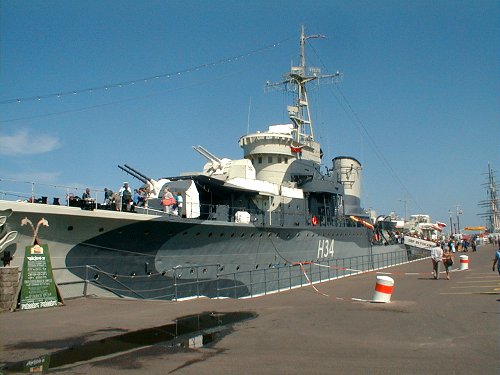
DUTY ON FRENCH NAVAL SHIPS
After a prolonged stay in the hospital, Wesolowski was returned to active duty and assigned to a French subchaser, The Chaser XV on July 26, 1940 as chief petty officer and assistant commander. He also served on the Chaser XI on several occasions when the other vessel was out of service. With the fall of France in 1941 the Polish Navy took over complete operation of these subchasers. Polish sailors flooded to Plymouth from all parts of Europe and the unavailability of ships forced them to serve with various other national naval forces fighting the war against Hitler’s armies. Wesolowski volunteered for duty with the French subchasers and his valor in this most dangerous of naval operations earned him the Croix de Guerre. The responsibility of these small vessels was to seek out German merchant shipping and submarines in the English Channel and La Manche areas. Coupled with the ever-dangerous military missions was the added problem of abominable weather conditions consisting of constant fog, rain, raw cold and snow.
The elements caused Wesolowski’s health to deteriorate rapidly and as a result he was declared unsuitable for further military activity. On August 8, 1941 Wesolowski was honorably discharged from active duty from the Polish Navy and reverted back to the Merchant Marine. After a short period of rest and rehabilitation Wesolowski chafed at the bit for active duty. Spurred by the fact that his wife and two sons were languishing under brutal conditions in Nazi occupied Poland, Wesolowski reported for duty at the headquarters of the Polish Merchant Marine in London. He was assigned to the crew of M/S Lechistan on February 10, 1942 as a radio operator. This assignment satisfied his desire to participate actively in the raging war against the Axis. He sailed on a number of ships during this period including the Swedish vessel S/S Hilmeren and the American tanker S/S Fairfax. His reputation as an officer grew continuously and he was commended for his seamanship and command ability under fire on several occasions.
THE AMERICAN EXPERIENCE
In November of 1943, finding himself temporarily in the Brooklyn Naval Shipyard, NY, Wesolowski was summoned to the Commanding General of the US Army Transportation Corps for a personal interview. Knowing the background of Wesolowski’s naval career and his capability as a commander, the general offered Wesolowski a position as second in command of an auxiliary aircraft carrier.
This was the only time in US history that a foreign national was to hold a command position in the armed forces of the USA. After expediting the formalities and procedures necessary to effect his appointment, Wesolowski was assigned to the auxiliary aircraft carrier, the USAT Ganandoc as second in command.
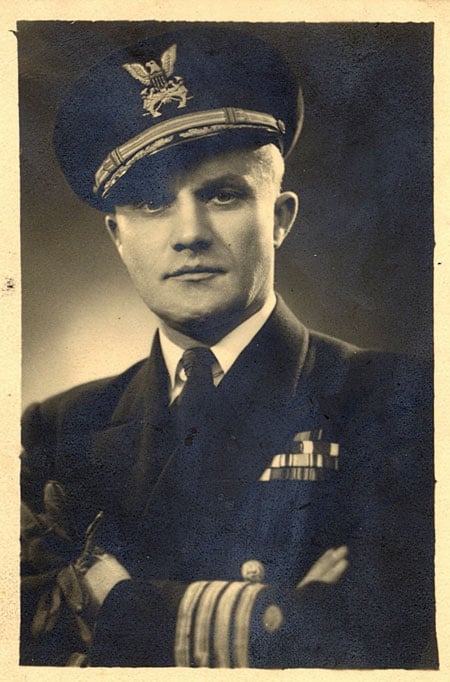
Stefan Wesolowski in US Army
The USAT Ganandoc ship was built in 1940 as an iron ore carrier but was converted at the Brooklyn Naval Yard into an auxiliary aircraft carrier. The lower deck held 65 fighter aircraft and 30 were in constant readiness on the flight decks. The mission of the USAT Ganandoc was to carry aircraft and supplies to United States forces through Halifax in Nova Scotia, across the Atlantic to Liverpool, England serving as part of the protective convoy against enemy aircraft and submarines.
During the course of the third voyage the commander fell ill with a heart attack and Wesolowski replaced him as commander. After extremely lucky years on the Atlantic and Murmansk patrols the Ganandoc was assigned to duty with the flotilla assembled for the invasion of Normandy. There, after delivering its cargo of tanks, planes and ammunition, the ship was hit by shore batteries and was so severely damaged that the high command issued orders for its scuttling. However, Wesolowski and his crew managed to bring her limping back to port in England, where after extensive repairs she was made fit once more.
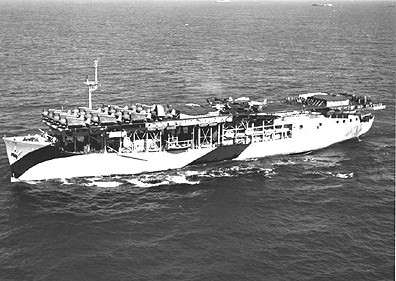
The whole ship was cited and decorated for this heroic achievement by Major General Frank Ross, Chief of the Army Transportation Corps, ETO. The General wanted to name a ship after Captain Wesolowski, but Wesolowski declined the honor.
The USAT Ganandoc.
His former Commander Colonel Robert L. Taylor wrote: „Captain Wesolowski served with distinction during the invasion of Europe between the period 6 June to 25 October 1944 and was cited for service to the United States above and beyond the call of duty. During his service Captain Wesolowski’s operational record, efficiency and devotion to duty and the American cause during the Second World War was exemplary and above reproach.” Later in 1985, Captain Wesolowski was decorated with the Bronze Star for Valor. Poland decorated Captain Wesolowski after the war with the Commanders Cross of the Order of Merit. During the time that USAT Ganandoc was under repair, Wesolowski changed command to a large ocean going tug, the USALT 533, and became involved in salvage operations and convoy duty.
On December 23, 1944 Captain Wesolowski discovered a minefield in the English Channel and successfully judged its location and movement enabling the convoy to clear the field with no loss of ships or lives. For this heroic achievement he was decorated and cited by Colonel Samuel A. Decker who wrote: „In recognition of conspicuously meritorious and outstanding performance of military duty did promptly and intelligently report the presence of enemy minefield in the English Channel, thereby unquestionably avoiding loss of life and shipping.” Major General Frank Ross recommended the naming of a ship in Captain Wesolowski honor but he declined this gesture. In March of 1945, Wesolowski resumed command of the USAT Ganandoc and served aboard that ship until the end of the war in Europe.
By 1944 the news spread in the Polish Navy that a Polish officer commanded an American aircraft carrier. On one occasion the ORP Blyskawica and the USAT Ganandoc were docked in the Port of Southampton. Curiosity motivated Polish sailors to pay a courtesy call on the Captain of the USAT Ganandoc. After being escorted to the captain’s cabin by a marine guard, the Polish sailors from the ORP Blyskawica were shocked to discover that their former petty officer was the captain of the Ganandoc. One said. „Stefan what the hell are you doing here”? They could not believe that Wesolowski held such an important command with the American forces, but was a former noncommissioned officer in the Polish Navy. The chief of the Polish Navy became aware of Wesolowski’s command and extended an invitation to visit the headquarters of the Polish Navy in London next time Captain Wesolowski was in town. Stefan finally accepted the admiral’s invitation. Upon arrival to the headquarters, the whole admiralty staff received him. During the interview, the admiral wanted to know how and why Wesolowski became a commander of an American aircraft carrier when in the Polish Navy he was only a petty officer. Captain Wesolowski replied that the Americans must have valued his expertise more then the Poles.
JOURNEY HOME TO POLAND
As the war drew to a close the thoughts of Captain Wesolowski became more and more concerned with the whereabouts and well being of the family left behind in Poland. The oppressive rule of Hitler’s occupation was only too familiar to him and he was constantly beleaguered by the fear that the Gestapo would wreak vengeance on his family. With the war’s end the destiny of a free Poland was still very much in question and the difficulties of Poland’s armed forces in returning to their homeland were manifold. However, on February 28th, 1946 Captain Stefan Wesolowski was granted a compassionate leave of absence from headquarters, US Forces ETO, and ordered to proceed to Paris, Berlin and then to Warsaw for the purpose of locating and visiting his family. This unprecedented order was authorized by General Eisenhower and signed by General McNary. Armed with this unusual, but invaluable, document, Wesolowski proceeded on his journey of reunion. On March 19, 1946 he landed in Warsaw aboard an American Air Force plane in the uniform of an American captain in the naval service.
The timing of this visit was dangerous because the communist forces were taking over the government of Poland. Even in the uniform of an American officer, Wesolowski as a Polish citizen was in danger of being arrested. The Warsaw that he left in August of 1939 was now a pile of dusty and still smoldering ruins. Searching frantically through the rubble of the once magnificent city he was able to locate his family alive and in relatively good health. Stefan had difficulty in obtaining exit visas for his family. He decided to personally petition the President of Poland, Boleslaw Bierut. During the interview the Polish President encouraged Captain Wesolowski to stay in Poland.
He enticed Captain Wesolowski by offering him the command of the Polish Navy with the rank of admiral. Wesolowski declined the invitation and after obtaining official documents necessary for expatriation he was able to move the family to Berlin and finally Paris. Wesolowski’s dream of returning to Poland had finally come true but he never imagined that he would return to his native land dressed in the uniform of an American officer and to find his country under the control of a communist government backed by the Soviet Union.
The long years of suffering, anxiety and unbearable tension were finally ended and the family spent a few weeks of happiness in Paris, that even in the post war year of 1946, seemed like paradise in comparison to Warsaw. Arrangements were made for their final journey to the United States and on July 20, 1946 Captain Wesolowski’s wife Antonina, and his sons Zdzislaw 11 and Jeremil 9, arrived in New York aboard the S/S Washington.

Passing the Statue of Liberty had a deep significance to them after the 6 years of war and deprivation. On the dock, anxiously waiting the final moment of reunion stood Captain Wesolowski with the New York press corps. Needless to say the joy of final and definitive reunion was an unforgettable and overwhelming experience for the entire family.
Shortly thereafter Captain Wesolowski was discharged from the US Army Transportation Service; he joined the American Merchant Marine where he sailed for another twenty years. After the war, Captain Wesolowski was invited by President Harry Truman to the White House. President Truman congratulated and thanked Captain Wesolowski for his services to the United States. After settling down with his family in Staten Island, Stefan became involved in various veteran organizations and assisted Polish refugees in the United States.
The citizenship of the United States was granted Captain Wesolowski and his family shortly after the war. During the passing years the Captain and his family settled in Staten Island, New York, and they were able to enjoy the peace and tranquillity of their adopted land. His sons grow up in the United States, the oldest son, Zdzislaw, joined the Air Force during the Korean War and later obtained a doctoral degree. At the present time he is a professor of aviation, management and economics at Florida Memorial College in Miami. The youngest, Jeremii, also received his doctorate and assumed several positions of responsibility in management of the pharmaceutical industry. He is currently living with his family in Yorba Linda, California.
Captain Wesolowski selected retirement in Miami Beach, Florida where he quietly reminisced on former battles won and lost and of ships of another time. His memories are vivid of his many nationals comrades-in-arms from the United States, Poland, France, Great Britain, Norway and Lithuania, who fought so gallantly for the preservation of our freedom. In a book „Under Foreign Flags” written by the famous Polish naval historian, Jerzy Pertek, Captain Stefan Ogonczyk Wesolowski was added to the annals of Polish naval history for his service to Poland and the United States. His decorations were bestowed by the United States, France, England, Norway, Lithuania and Formosa. Amongst the most cherished mementos of his career is a letter of commendation from President Harry S. Truman dated February 24, 1948. Adding to the list of recognition of his magnificent service to the cause of liberty was the Bronze Star for Valor presented on the 35th anniversary of D-Day. His years of retirement have been fruitful and full as all sailors the nostalgia for the sea, and its challenges, will remain forever.
Captain Wesolowski wrote his memoirs „Od Gazoliny do Ganandoca” and they were published in Poland in 1983. This story of courage, faith and intensity of love for freedom is one that was greeted with great anticipation throughout Poland and the United States. One month after publication, the book was sold out.
World War II was a time of extraordinary hardships for many families in the United States. Separations caused by sons, brothers, fathers and husbands in service with the Armed Forces, and the subsequent dangers of loss of life or serious injury, caused torment in thousands of families, in thousands of ways. In spite of these horrors of war, the torments were minute in comparison to those faced by the families who were in direct subjugation to enemy forces on the soil of Poland. Antonina Wesolowski, the wife of Captain Wesolowski, just as Captain Wesolowski was a hero in every aspect of the word, so too was Mrs. Wesolowski a heroine. Hers is a story that typifies the courage shown over and over again by so very many Polish women and children who existed through the war years on the strength of their faith and courage.
Mrs. Antonina Wesolowski, the wife of Captain Wesolowski was born in Bielce on May 13, 1913 to a merchant family from Poznan. Her family was also involved in the fight for Polish Independence. Her father moved his family to Gdynia in 1932 where he established a flourishing business. It was in Gdynia that Antonina and Stefan met, and on September 25, 1933, the two were married.
At that time, Captain Wesolowski was on the staff of the Gdynia Port Authority as a pilot. Several years later the family had grown to four with the additions of their firstborn, Zdzislaw, and their youngest son, Jeremii. The young family settled down to a quiet life in the recently built city of Gdynia. All was quite serene and for a few happy years Antonina enjoyed the life of a typical wife of a naval officer and Polish hero. In 1938 the family was already planning Captain Wesolowski’s retirement from government service and had even started to look for a retirement country estate. Captain Wesolowski planned to retire in 1940, after over twenty years in the service of his country, at the age of 31. He was looking forward to a life of quiet leisure as a country gentleman, engaging in his various hobbies and veteran’s group activities. Little did the Wesolowski family realize that a year later, Hitler had other plans for them and the rest of the Polish people.
IN NAZI OCCUPIED POLAND
Early in August of 1939 Stefan, a naval reservist, set out on his annual training cruise. Antonina and the two boys bade him goodbye and left Gdynia for a vacation near Osiek Sandomierski to wait for his return. Plans called for him to rejoin his family after the training cruise for a summer holiday. The family had no idea that this was to be a parting that would last seven long years. Several weeks later, at the home of her parents, Antonina learned that the political situation with Germany was very dangerous and a strong possibility existed that there would be a war. Rumors grew all the stronger and soon became a terrible reality. Antonina realized that Stefan would be reinstated to active duty and would be fighting for Poland. Antonina all too frighteningly anticipated the fear of war and the terrors it would bring. She now had to assume the role of mother in the worst of times as she indeed was left to care for her sons alone during the invasion of Hitler’s army. At the time, Zdzislaw was only 4 and Jeremii 2 old.
During the battle for Osiek, their house was destroyed and burned down. All the family possessions were lost and Antonina and the children were left with nothing except the clothes they were wearing. Zdzislaw still remembers vividly how they escaped the battle zone by running across the line of fire between the Polish and German armies. For a while Antonina and her children stayed in HeIm-Lubelski and were later able to join her family where they spent most of the war.
Captain Wesolowski was back on active duty assigned to a Polish destroyer, the ORP Blyskawica. His ship and a small flotilla left for England, joining the British fleet in its fight with the German Navy. By the end of September 1939, Gdynia lay in ruins and Poland’s armed forces surrendered to the Germans. Life in Poland during the occupation was a life of utter terror and a constant fight for survival. Survival during the war cannot be described with mere words; however, the hardships and responsibility for her two sons and elderly parents were a heavy burden on Antonina’s shoulders. She and other Poles were pressed into forced labor and she was able to feed her sons and parents by sharing the rations that she received as a hospital worker.
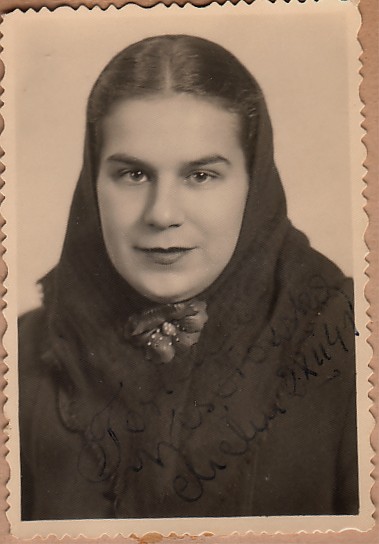
It was not until years had passed that Antonina received a letter from Stefan postmarked London. She and the boys were overjoyed to learn that Stefan was still alive and fighting in England for Poland. This was the first time she learned that he was well but very worried about them and waiting for the day that the war would end so they could be together again.
From time to time Antonina would receive other letters from Stefan via Switzerland where a friend would forward his letters to her. The Gestapo, in the meantime, was censoring her mail and became suspicious and ordered her arrest.
Antonina Wesolowski in 1941.
One day in the Fall of 1944, an armed personnel vehicle stopped in front of the house and armed German soldiers surrounded it while the Gestapo burst in and arrested Antonina. Her sons and parents, as well as all the other inhabitants of the village were alarmed and terrified about the final outcome of this arrest. All too frequently an arrest by the Gestapo resulted in the disappearance or death of the person arrested.
During the interrogation Antonina was questioned about the letters from London and Zurich. The Gestapo insisted upon knowing the identity of Stefan. Antonina was sure that they knew very well who he was but wanted to see what her reaction would be. She told them that Stefan was her husband. After a hearing and additional questioning the Gestapo released Antonina. No words can describe the terror felt by the whole family during this ordeal because in the war year’s people were executed for less reason than that. Antonina and the boys thank God for saving their lives and those of the whole family for she and the boys could have been executed. For the rest of the war they lived in constant fear of being arrested again – and having witnessed executions at the hands of the Germans, they feared the worst.
Antonina and her son, Zdzislaw, still carry vivid memories of one battle in Osiek. This was the day that, after the battle, they buried a young Polish soldier who was no more than 17 years of age and carried no identification other than a wooden cross worn around his neck; evidently the parting gift from a loving mother. With their bare hands Antonina and Zdzislaw dug the shallow grave and buried the young soldier in the soft earth of Poland.
To this day Zdzislaw wonders who he was and has pledged to make an attempt to find the grave on his next visit to Poland. They do remember that it was in the garden of the Staszewski family on Ulica Koscielna in Osiek-Sandomierski. Zdzislaw has vowed to himself that he will find the grave of this Polish Unknown Soldier. Antonina worried about her children’s safety, their education and their very lives. Since schools were closed, she started to teach them herself and on several occasions there were periods of time when they were able to attend small underground schools before they were discovered and closed by the Germans. Antonina did her utmost to provide loving care for her children as well as her parents, but by the end of the terrible war, both of her parents had died.
END OF WW II
When the war was finally over, Antonina and her sons journeyed via open rail flatbed and horse drawn wagon from Ostrowiec to Gdynia.
In the spring of 1945 they reached Gdynia after a horrifying journey which had taken many weeks. On that trip they viewed the ravaged Polish cities and villages and saw the dead and unburied bodies strewn about everywhere. Half-starved, ragged people were a common sight on the Polish landscape. Returning people searched for missing friends and relatives, looking for former streets and buildings which no longer existed; only rubble was evident everywhere. The refugees numbered millions and all were seeking information about those who were dead or alive.
Only God knew the answers to the questions of many. Several weeks passed and word was spread that the Polish Navy was returning from England and on the 24th of October 1945 the small flotilla of the Polish Navy returned to Gdynia. Zdzislaw and Jeremii were hoping that their father would be among those returning; however, standing some distance near the docks, the boys did not see their father getting off any of the ships.
They were disappointed and wondered whether he was still alive and whether he would ever return to them. Time passed slowly until Antonina finally received a telegram from Stefan telling her that he was returning to Poland to take them to the United States.
FAMILY REUNITED
On March 18, 1946 Captain Wesolowski was in Frankfurt, West Germany arranging a flight to Warsaw on the first available US. Army Air Force aircraft. He was able to secure a seat on the airplane, however a young mother with a little girl pleaded with him to give up his seat because she had to get to Warsaw on that day because of a death in the family. Touched by their plea, Captain Wesolowski agreed and gave up his seat. Moments after the aircraft took off, it crashed and all persons on the plane were killed. His generosity had saved his life. Destiny and God watched over him, as it had through all the war years. The next day Stefan was able to get another seat and arrived safely at the Warsaw airport. The base commander at that time commented that Stefan lived a charmed life and indeed was lucky to be alive.
After Antonina received the telegram that Stefan was arriving, she left Gdynia with the boys and set off to Warsaw to meet him. The joy and anticipation of the reunion after all the years of separation and suffering was almost unbearable. Zdzislaw and Jeremii wondered aloud whether they would recognize their father but Zdzislaw was sure that he would. When Stefan’s originally scheduled flight failed to arrive when expected, Antonina and the boys returned to their relative’s home to await further word on the new arrival time from Frankfurt. Shortly thereafter, Stefan arrived, unannounced, and went directly to the relative’s home in the Warsaw-Praga district. On the way he was spotted by his son Zdzislaw, who was playing outside, and who immediately recognized his father in the uniform of an American naval officer. No words can describe the reunion of the whole family. The long, heartbreaking separation was finally over!
Several days later, Stefan made arrangements to have his family leave with him for the United States. Upon their arrival in France via Berlin, Stefan received orders to return to his ship, the USAT Ganandoc, an auxiliary aircraft carrier that he commanded, for its last voyage home. Antonina and the boys had to wait their turn to board the Army transport ship, the SS Washington, for the trip to the United States.
By that time Stefan was already in New York, making arrangements for their new home in Staten Island. On the early morning of July 20, 1946 the SS Washington with Antonina and the boys aboard, made its way past the Statue of Liberty and the New York skyline. The family will never forget the joy of arriving in the United States where on the dock awaiting them was Captain Wesolowski, surrounded by many newspaper reporters. The following day the New York and national papers published stories and photos about the Wesolowski’s and especially about Captain Stefan – the first foreigner, who was not a citizen of the United States, to command an American warship during war time. The Wesolowski family who treasure their American citizenship and are very happy to live in a democratic society will always remember July 20, 1946. They are also proud of their Polish heritage, a nation that has for a thousand years fought for its right to exist against one tyranny or another.
Antonina was a rare woman, mother and wife, dedicated to her family in the finest tradition of Polish womanhood. She was responsible for keeping the family together in the bleakest of times, providing love and care for both husband and children. The results of her dedication and hard labor through history’s darkest days are two sons, both holding doctoral degrees and positions of responsibility in American society; grandchildren, and a loving husband – all whom shall forever cherish her contribution. Captain Stefan P. Wesolowski and his wife Antonina retired to Miami Beach. After many years of retired bliss, Captain Wesolowski passed away in 1987 and Antonina in 1992. They are buried together at the family gravesite in the Miami Catholic Cemetery. Their contributions to both nations will be remembered always.
_______________________________________________________________________________________
ABOUT THE AUTHOR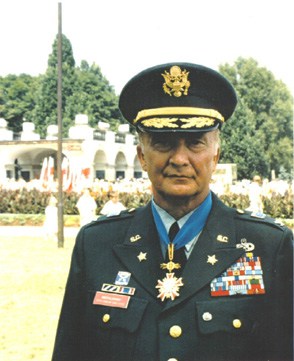
Prof. Dr. Zdzislaw P. Wesolowski has taught at Florida Memorial University in Miami for the last 30 years.
He is a retired US Air Force Captain and a Colonel in the Reserve of the South Carolina State Guard. Col. Wesolowski would be pleased to communicate with former members of the USAT Ganandoc who served with his father during WWII as well as Polish veterans who served with him aboard the ORP Blyskawica or other Polish ships.
Professor Wesolowski can be contacted at:
PO Box 291465 Davie, Fl. 33329 USA.
E- maill: professor1792@aol.com
Internet http://www.wwdir.com/polishbk.html
DECORATIONS OF CAPTAIN STEFAN P. WESOLOWSKI
POLAND
• Wound Bar of Honor with three stars
• Order of the Virtuti Militari, 5th class
• Order of Merit, Commander
• Independence Cross
• Cross of Valor, 1920
• Cross of Valor, 1940
• Cross of Merit with Swords, 2nd class, 1942
• Cross of Merit , 3rd class, 1935
• Central Lithuanian Cross of Merit and Gallantry, 1921
• Silesian Cross, 1921
• September 1939 Cross
• Polish Forces in the West Cross with Sea Battles and Convoy Bar
• Silesian Uprising Cross, 1944
• Medal for the War with the Soviet Union 1918-1921
• Medal for the Restoration of Independence, 1935
• Navy Medal, 1945
• Merchant Marine Medal, 1945
• Medal for the September 1939 War
• Medal Rodla
• 20 Year Military Service Medal for Long and Faithful Service
• 10 Year Military Medal for Long and Faithful Service
• Silesian Grand Cross
• Wolyn Grand Cross
• Wolyn Cross of Valor with Swords
• Volunteer Army Cross of Valor
• Balachowicz Cross of Valor
• Cross of Freedom and Independence
• Veterans of Freedom and Independence Cross
• Regimental badges;
• 16th Infantry Regiment
• Hussars of Death
• Disarming Germans in Warsaw
• Lwow Orleta badge
• Lwow Defense Cross with Swords and Virtuti Militari
• Lithuanian-White Russian Front
• Silesian Star for the 3rd Silesian Uprising
• Army Volunteers
UNITED STATES OF AMERICA
• The Bronze Star for Valor
• Certificate of Merit. US Army
• Meritorious Unit Citation, US Army
• Merchant Marine Combat Medal
• Merchant Marine Atlantic War Medal
• Merchant Marine Pacific War Medal
• Merchant Marine Mediterranean-Middle East War Medal
• Merchant Marine World War II Victory Medal
• Conspicuous Service Cross, The State of New York
• Citations and Commendation awards
ENGLAND
• The 1939-1935 Star
• The Atlantic Star
• The War Medal, 1939-1945
• The Defense Medal WWII
FRANCE
• Croix de Guerre with Palm CHINA
• War Memorial Medal for World War II NORWAY
• The 1940-1945 War Medal EUROPE
• European Combatants Cross, WW II
SOVIET UNION
Refused to accept two decorations


